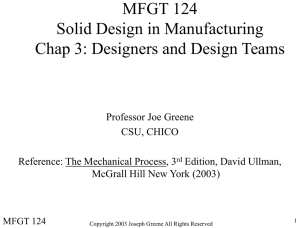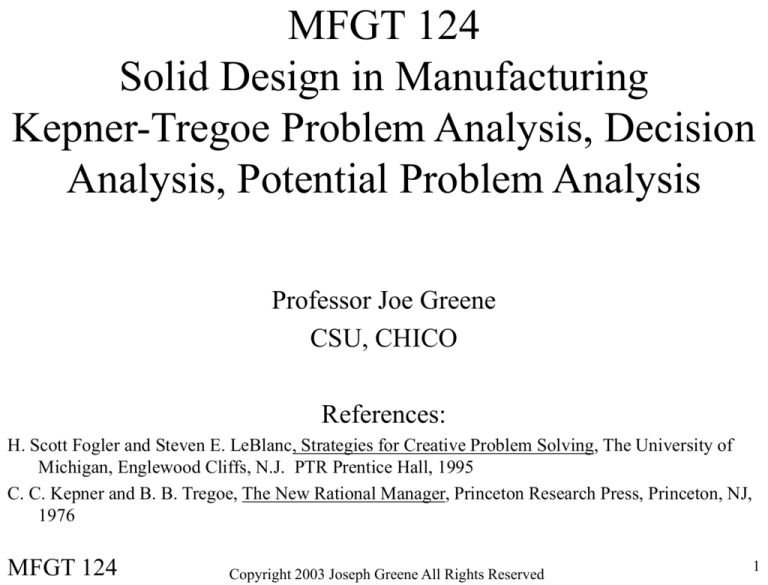
MFGT 124
Solid Design in Manufacturing
Kepner-Tregoe Problem Analysis, Decision
Analysis, Potential Problem Analysis
Professor Joe Greene
CSU, CHICO
References:
H. Scott Fogler and Steven E. LeBlanc, Strategies for Creative Problem Solving, The University of
Michigan, Englewood Cliffs, N.J. PTR Prentice Hall, 1995
C. C. Kepner and B. B. Tregoe, The New Rational Manager, Princeton Research Press, Princeton, NJ,
1976
MFGT 124
Copyright 2003 Joseph Greene All Rights Reserved
1
Chap 3: Problem Solving
• Topics
–
–
–
–
–
Introduction
Situation Analysis
Problem Analysis
Decision Analysis
Potential Problem Analysis
Copyright 2003 Joseph Greene All Rights Reserved
2
Introduction
•
Kepner-Tregoe
– Once real problem is defined, then there are a number of possible
solutions.
– Time is needed to make a decision.
•
•
•
–
Decide which problem to work on first.
Choose the best alternative.
Decide how to successfully implement the solution.
Organized approach to making decision. KT New Rational Manager
Situation Analysis
(Where are we?)
Decision Analysis
Potential Problem
Analysis
Past
Present
Potential
What is
the fault?
How to correct
the fault?
How to prevent
future faults?
Problem Analysis
Copyright 2003 Joseph Greene All Rights Reserved
3
Situation Analysis
•
In many cases many problems arise at the same time.
–
–
Sometimes they are interconnected and other times they are totally unrelated.
Need to prioritize the problems.
•
•
•
•
Timing
Trend
Impact- Cost, environment, legal
Criteria
–
Timing
•
–
How urgent is the problem? Is there a deadline? What are consequences if nothing is
done?
– Priority - High, Moderate, Low
Trend
•
What is potential for problem growth? Is this a beginning of a pattern that could
make matters much worse?
–
–
Priority - High, Moderate, Low
Impact
•
How serious is the problem on other parts of the organization, e.g., people,
equipment, products, policies?
–
Priority - High, Moderate, Low
Copyright 2003 Joseph Greene All Rights Reserved
4
Situation Analysis
•
Example, First Day Blues…. Pg 90
Major concern Subconcern
Space
Unopened boxes
20 new desks
Personnel
Employee Morale
Finances
Money Owed
Money Due
Quality
Scratched Desk
–
Timing
L
H
M
M
M
L
Trend
L
H
M
M
M
L
Impact
L
H
H
H
M
M
Process
DA
DA
PA
DA
PA
DA/PPA
Observations
•
•
•
•
•
•
Boxes are an eyesore and awkward to step around,
– It it not necessary now; Timing (L)
– It will not get worse; Trend (L)
– It won’t cause any problems if they are left in boxes for now; Impact (L)
20 new desks are an immediate problem, will get worse if ignored, and is greatly
affecting the staff effectiveness. (H, H, H). Decision Analysis is needed
Employee moral is important and needs to be addressed soon before it gets worse and
causes other sloppy mistakes. Problem analysis is needed to figure out why moral is so
low.
Utility bills need to be paid soon so that utilities won’t be cutoff.
The finances need to be put in order so that future problems are avoided. Problem
analysis is needed to figure out what is causing the money problems.
Scratches on desk are annoying but can wait. Need to figure what process failure
caused the desks to be scratched with Potential Problem Analysis.
Copyright 2003 Joseph Greene All Rights Reserved
5
Situation Analysis
•
Pareto Analysis and Diagram
–
–
–
–
Pareto Principle: 80% of trouble come from 20% of the problems
Used to prioritize all problems and decide which to attack first.
Highlights which problems are important and which are trivial.
Method
•
•
•
List problems and the associated degree of the problem; quality problems, costs, lost
time.
Using a bar chart the problems with the highest degree of problems are listed on the left
and those with least amount of problems are on the right.
Example, Toasty O’s quality problems in (Pg 91)
– Number of out of spec boxes.Most important is No Prize in Box.
– Amount of lost revenue from quality problem. Most important is Stale cereal.
Pareto Analysis, TostyO's Quality Problems
Pareto Analysis, TostyO's Quality Problems
50
40
30
Series1
20
10
0
No prize
Overfilling Stale from
Inner
wrapper
Inferior
Printing
Shipping
Damage
Lost Sales , $K
No. of Boxes, K
60
$100.0
$90.0
$80.0
$70.0
$60.0
$50.0
$40.0
$30.0
$20.0
$10.0
$0.0
Series1
Stale from
Inner
wrapper
No prize
Copyright 2003 Joseph Greene All Rights Reserved
Shipping
Damage
Overfilling
Inferior
Printing
6
KT Problem Analysis
•
Experienced problem solvers ask the right questions.
–
KT problem analysis helps you ask the right questions.
•
•
•
•
•
•
–
–
What is the problem and
– what is not the problem?
Where did the problem occur?
– Where is everything OK?
When did the problem first occur?
– When was everything OK?
What is the magnitude (extent) of the problem?
Who was involved?
– Who was not involved?
Why is it important?
– Why is it not important?
Table 5-1
Example, Fear of Flying Pg 95 plus handout.
Copyright 2003 Joseph Greene All Rights Reserved
7
KT Decision Analysis
•
How to choose the best solution from a number of
alternatives.
–
KT decision analysis is a logical algorithm to chose between
different alternatives..
•
•
•
–
–
–
Separates desires into two categories. These items are how the decision will be
evaluated.
– Musts- essential things that must occur.
» Have Go- No Go options for alternatives that do not meet Musts
– Wants- necessary things that would make it better.
Weight scale is given for each evaluation item.
Add up the weighted points to determine the best solution.
Weighting scheme can be used for negative consequences too.
Example, Finding a job Pg 102 plus handout.
Cautions
•
•
Subjective method
Be careful not to bias weighting for a predetermined alternative or blackball
another one.
Copyright 2003 Joseph Greene All Rights Reserved
8
KT Potential Problem Analysis
•
After making decision, need to ensure its future success.
–
Look into the future.
•
•
•
See what could go wrong.
Make plans to avoid these pitfalls.
KT Potential Problem Analysis
–
Decreases possibility of disastrous outcome.
•
Lists
– Potential problems
– Possible causes
– Preventative actions
– Contingent Action
KT Potential Problem Analysis
Potential ProblemPossible Causes
Preventative Action
A.
B.
•
Contingent Action
Example Ragin Cajun Chicken- Pg 105- Handout
Copyright 2003 Joseph Greene All Rights Reserved
9

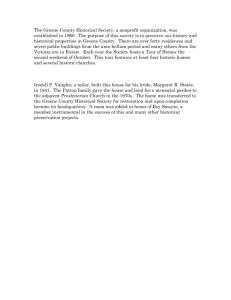
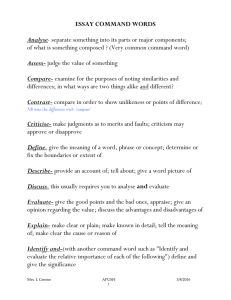
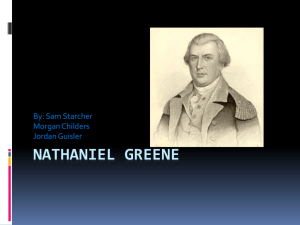
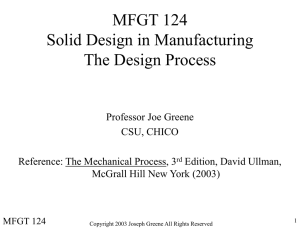
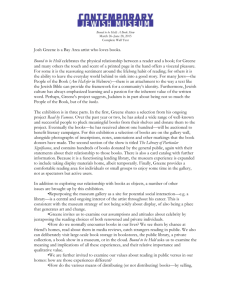
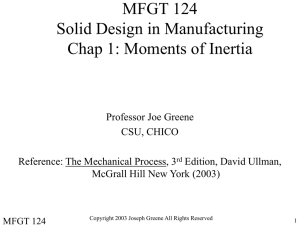
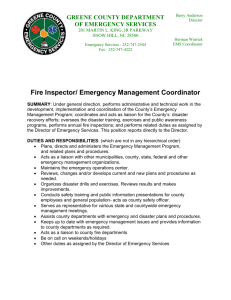


![Title of the Presentation Line 1 [36pt Calibri bold blue] Title of the](http://s2.studylib.net/store/data/005409852_1-2c69abc1cad256ea71f53622460b4508-300x300.png)
